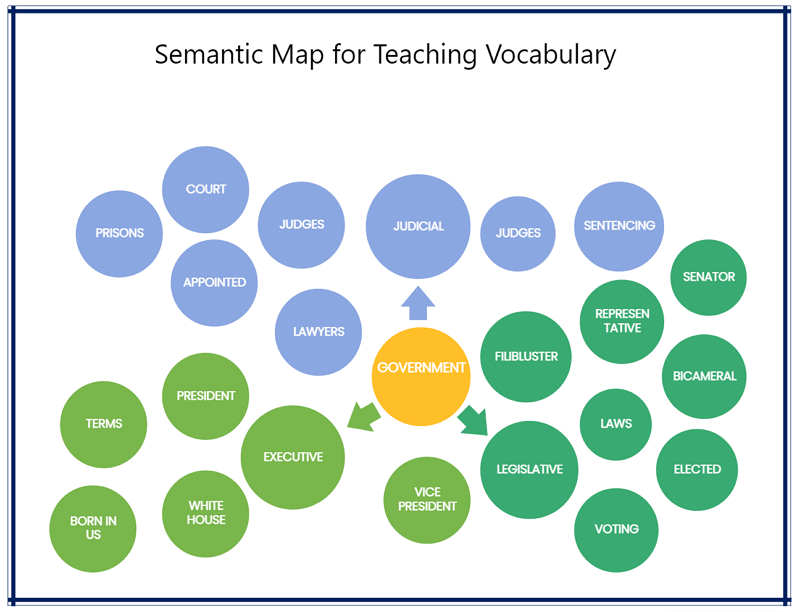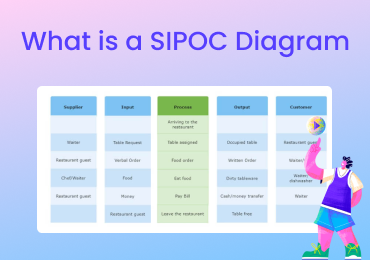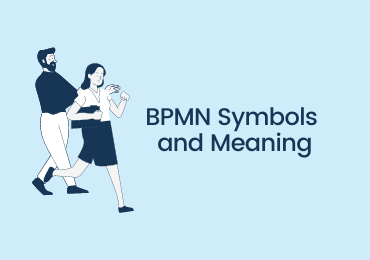What is Semantic Mapping?
1. What is a Semantic Map?
In common looks, semantic maps look like any other graphic organizer. However, they are used mainly for educational purposes. Semantic maps are drawn based on the previous knowledge of the students so that they can connect new words with what they already know. As a result, their vocabulary will be enriched and so on. A semantic map has three components. The first one is the concept or the core question. The second one is the strands that help clarify or explain the main concept. And the third one is the supporting information that helps build better connection between the concept and the strands.
The fundamental purpose of semantic maps is to help students associate new word meanings with their prior knowledge in an easy method. And semantic maps help them do it more easily than traditional educational methods. As easily understood, semantic maps are commonly used in educational institutions, schools to be more specific. Since its introduction, it has proved to be quite useful as a teaching strategy.
Source: EdrawMax Online
2. Benefits of Semantic Map
Semantic maps are an excellent educational tool, which has a number of benefits. Here are some of the benefits of semantic maps pointed out.
Creativity: Creativity, when combined with education, makes a great team, which in turn helps students learn new things easily and more effectively. Also, the creativity lets lots of new ideas come fluently.
Categorizing: Remembering a huge pile of information is among the hardest tasks. However, if you can categorize it properly, it gets easy to keep them in mind. By using semantic maps, categorizing has become easier than ever.
Requires no or less preparation: Most educational tools require the teacher or instructor to take some preparation themselves. However, semantic maps do not require anything as such. Yes, a little preparation will make things better. But no serious preparations are to take.
3. Teaching Students to Use Semantic Maps
Although semantic maps make things easier to understand, you must know how to present them before your students. Here are the steps that you can follow to teach students to use semantic maps.
- At first, you need to explain the whole scenario to the students. You need to explain the purpose of the mapping and how you are going to do it.
- Secondly, you can have students work in groups or pairs. In some cases, having them work individually is a better option.
- As you read through a text, you can pick some words that are closely connected or may not be connected at all and write them on the board or on whatever digital presentation you are showing them.
- Now, you need to have the students sort the similar words into groups. It is better if they can describe how the group involves the word and how other groups don’t.
- Step three and four can be done vice versa. In that case, you will create a heading or a concept word and make the students find the related words and make the map.
While taking only a few minutes of your day, semantic maps can play a vital role in the teaching strategy.
4. How to Create an Semantic Maps?
Creating semantic maps from scratch by yourself can be intimidating. However, there are online tools to help you with that. Such an excellent and efficient online tool to create semantic maps is EdrawMax Online. You can do the whole process online while having the best results. Creating semantic maps takes only four easy steps.
Firstly, you need to log in to EdrawMax Online. You can simply click here and provide the necessary login credentials. If you don’t have an account, you need to create an account. It will take no time.

Once you log in, you will find yourself at the home page with lots of templates. You will have to choose the template based on what type of semantic map you want to create. At first, choose a category and click on the “+” to start a new blank canvas. Or you can go to the template library and choose a template from there.

As you choose the template, it is time to customize it the way you want it to look. You can select the shape library and drag and drop components from there to the map. You can draw and format connections to make things look interconnected. Furthermore, you can align, format, and give any style you want to the template. Finally, you can use different drawing tools, color fill, theme features, auto theme, etc., to give it a beautiful and persuasive look.
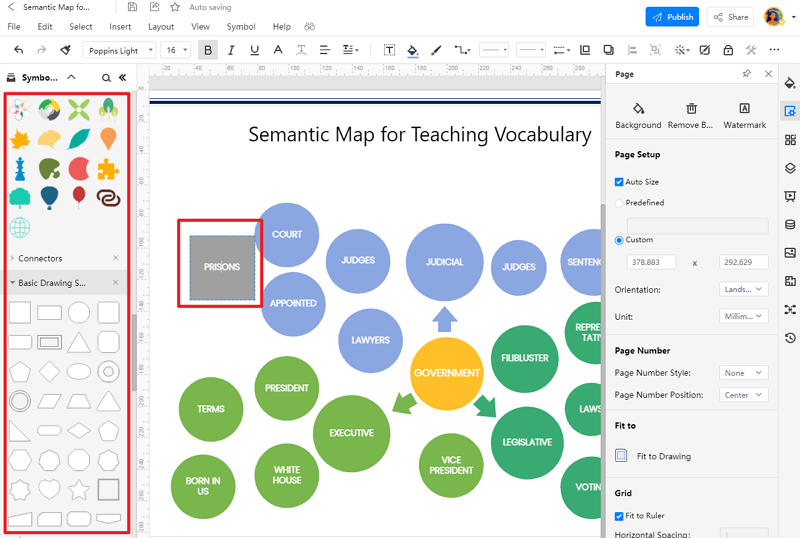
Once your creation of the semantic map is done, you can simply save and export it to your device. And if needed, you can share it accordingly.
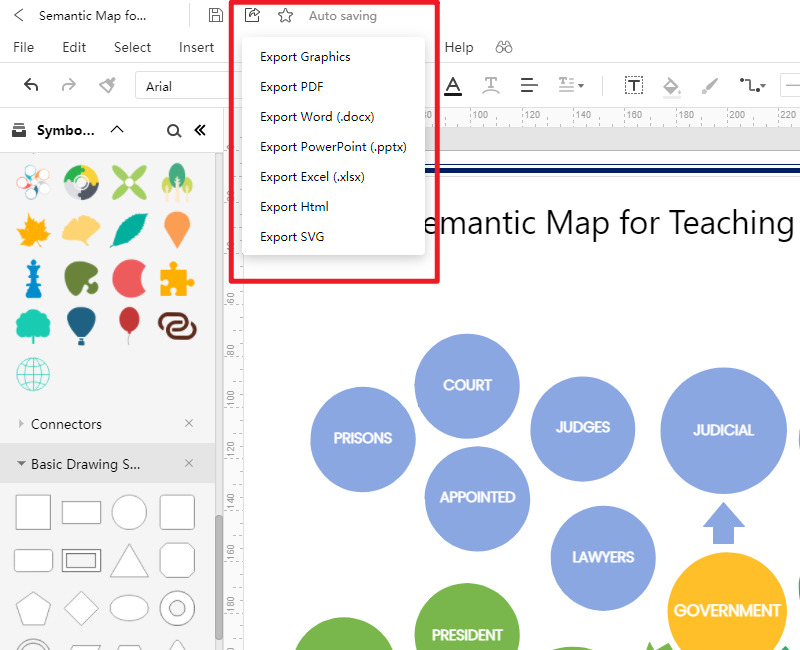
5. Useful Semantic Mapping Templates
Being an easy way to present things graphically, semantic maps can be the easiest tool to learn something new. Although semantic maps can be used in a wide range of cases, their most common use is for educational purposes. Here are some of the semantic map examples.
Example 1: Semantic Map for Vocabulary
One common use of semantic maps is teaching young students new words i.e., vocabulary. In fact, it is the most common use of semantic maps. In this case, the word at the center is the concept or the topic you want the students to learn about. The vocabulary i.e., the new words you want to teach the students are then connected via some straight lines. If the concept is a vast one, you can put it at the center and then create some sub-centers to divide it into some small parts.

Example 2: Semantic Word Map
Semantic word maps are quite the similar to semantic maps for vocabulary. However, in this case, the related words are not some additional vocabularies that the learner needs to know the meaning of. Instead, the concept or the word at the center simply is some topic you want the learners to learn about. Then, you put the related words around the concept word to help the learners easily recognize them later and use accordingly.

Example 3: Semantic Map for A Teaching Strategy
In terms of a teaching strategy, semantic maps can be of a number of types. The previous ones, vocabulary and world map, are also parts of teaching strategies. However, semantic maps can be used in some other exceptional ways. For example, you can easily use them to teach students different classifications. You can easily create a semantic map to indicate divisions and sub-divisions. Some teachers also use images to make things more easily understandable.

6. FAQs About Semantic Mapping
What is the tertiary level of a semantic map?
Semantic maps usually have two or three levels. The concept word at the center makes the primary level. In some cases, the semantic map ends with just another level surrounding the primary one. This surrounding level is known as the secondary level. And in most educational purposes, the use of a third level is noticed. It is the tertiary level of a semantic map. In most cases, they involve examples of the previous level.
What is semantic web?
In the present world, semantic web is known as the other name for World Wide Web i.e., the internet. It is a proposed development of the WWW where data in different web pages are well-structured and tagged in a way that they can be read by the computers directly. However, in simple terms, semantic web denotes the semantic connection, between words. You can also call them the connection pattern seen in a diagram.
How to use semantic maps for teaching vocabulary
For teaching vocabulary, the best way to use semantic maps is to first choose a word from the text being used. It can be from a story, a textbook, or any other text in the curriculum. The teacher needs to write it on the board, ensuring it is visible to everyone in the room. The teacher can then have the students look for words that are near this word or connects to it somehow. When there is a good number of words on the board, the teacher will make a map of it and help students understand the connection.
Wondershare EdrawMax
EdrawMax is the easiest diagramming tool that serves all your purposes. Try Free Online now!




7. Key Takeaways
Semantic maps can make your teaching fun and effective. With proper tools, you can create even more influence on the students. EdrawMax Online is there to help you with semantic mapping. With hundreds of templates and symbols to choose from, creating an effective semantic map has become easier than ever.
